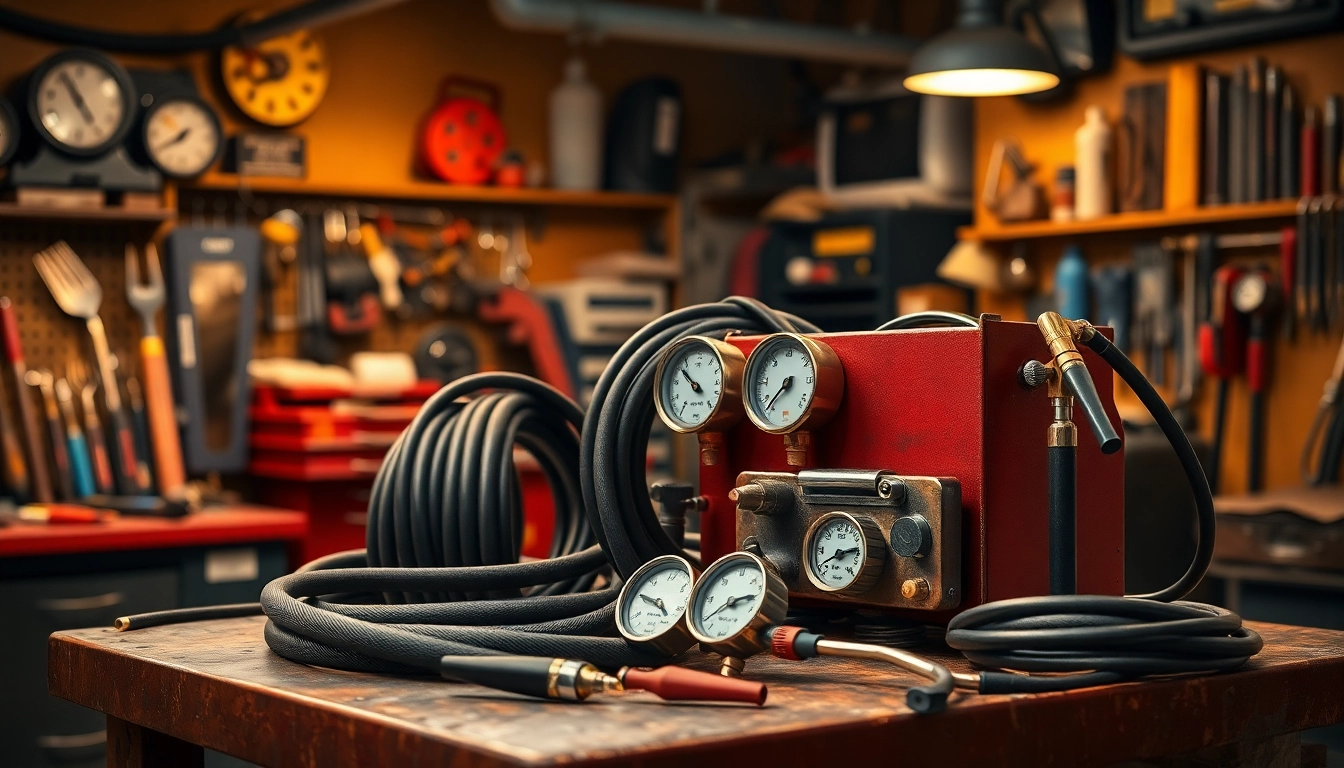1. Understanding the Oxy Acetylene Welding Kit
1.1 What is an oxy acetylene welding kit?
An oxy acetylene welding kit is a versatile and integral toolset used in various metalworking applications including welding, cutting, brazing, and heating. This kit utilizes a combination of oxygen and acetylene gases to produce a high-temperature flame capable of melting and fusing metal. The oxy-acetylene process has been a cornerstone of metalworking and fabrication since its inception and continues to play a crucial role in industries ranging from auto body repair to artistic metal sculpture.
1.2 Key components of the welding kit
Typically, an oxy acetylene welding kit consists of several vital components that work in conjunction to facilitate effective welding. These include:
- Oxygen and Acetylene Tanks: These cylinders store the gases under high pressure. The oxygen tank is usually green, while the acetylene tank is commonly red.
- Regulators: Essential for controlling the pressure of gas being delivered from the tanks to ensure safety and precision. Each gas will have its own regulator.
- Hoses: Color-coded hoses facilitate the flow of gas. Oxygen hoses are typically green, and acetylene hoses are red.
- Welding Torch: This is the handheld tool where the gases mix to create the flame. The torch usually has controls for adjusting the gas flow and flame characteristics.
- Welding Goggles or Glasses: Safety gear is essential to protect the eyes from the bright flame and harmful UV light.
- Welding Nozzles: Used to create different flame sizes and shapes for various tasks.
- Filler Rods: Supplemental materials for joining metals, available in various alloys to match the base materials.
1.3 Benefits of using oxy acetylene for welding
The oxy-acetylene welding process offers several advantages that make it popular among professionals and hobbyists alike:
- High Versatility: It can be used for welding ferrous and non-ferrous metals, allowing it to tackle a wide range of projects.
- Portability: Oxy-acetylene setups can be made relatively portable, making them usable in different locations, whether in a workshop or on-site.
- Temperature Control: The ability to adjust the flame temperature provides precision in the welding process, accommodating various thicknesses and types of metal.
- Cost-Effective: Unlike some modern welding methods, the initial investment for oxy-acetylene kits remains relatively affordable.
- Ease of Use: With basic training, beginners can quickly learn to use oxy-acetylene, making it an accessible option for DIY enthusiasts.
2. Choosing the Right Oxy Acetylene Welding Kit
2.1 Essential features to consider
When selecting the right oxy acetylene welding kit, several critical features should be considered to ensure that you choose a kit that meets your specific needs:
- Size of Tanks: For smaller projects, portable tanks may suffice, while larger projects may require more extensive setups with larger tanks.
- Regulator Quality: Look for high-quality regulators that allow for fine adjustments in gas flow, ensuring a steady flame.
- Durability of Hoses: Quality hoses should be resistant to kinks and abrasions for reliable long-term use.
- Welding Torch Type: Consider whether a standard or specialty torch is required based on your project needs.
- Included Accessories: Kits that come with essential accessories like nozzles, goggles, and filler rods usually provide better value.
2.2 Comparing options: Price and quality
Pricing for oxy acetylene welding kits can vary widely depending on brand, components, and included accessories. As you compare options, keep these points in mind:
- Entry-Level Kits: Often priced around $100-$300, these kits are suitable for home use and small projects.
- Professional Kits: Ranging from $400 to over $1000, these kits typically feature larger tanks and higher quality components for heavy-duty applications.
- Brand Reputation: Established brands often provide more reliable products backed by customer support and warranties.
- Resale Value: Investing in a well-known brand can also mean better resale value if you decide to upgrade later.
2.3 Popular brands and their offerings
Several companies dominate the oxy acetylene welding kit market, each with distinct features and price points:
- Victor: Known for high-quality, reliable welding equipment, Victor kits are favored by both professionals and amateurs.
- Harris: Offers a range of affordable kits suitable for starters while maintaining good quality.
- Lincoln Electric: A trusted name in welding, their kits are often used in industrial settings.
- Smith Equipment: Specializes in compact and lightweight kits, making them ideal for portable use.
- Unimig: Provides various options tailored for both beginners and advanced users, often at competitive prices.
3. Safety Measures with Oxy Acetylene Welding
3.1 Protective gear: What you need
Safety should always be the first priority when using an oxy-acetylene welding kit. Key protective gear includes:
- Welding Helmet or Goggles: Essential for protecting your eyes from intense light and UV rays.
- Flame-Resistant Clothing: Wear long-sleeved shirts and pants made from flame-retardant materials.
- Gloves: Heavy-duty gloves protect your hands from burns and hot materials.
- Respirators: Depending on the environment, consider using a suitable respirator to protect against fumes.
3.2 Common hazards and how to avoid them
Understanding the hazards associated with oxy-acetylene welding is crucial for maintaining a safe working environment. Some common hazards include:
- Fire and Explosions: Always keep a fire extinguisher nearby and avoid using the equipment near flammable materials.
- Gas Leaks: Regularly check hoses and connections for leaks. A soapy water solution can help detect leaks easily.
- Fume Inhalation: Ensure adequate ventilation in your workspace to limit exposure to harmful gases.
- Burns: Be aware of hot surfaces and materials, and handle all components with care.
3.3 Safe handling and storage of equipment
Proper handling and storage of your oxy-acetylene equipment can prevent accidents and prolong the life of your kit:
- Secure Storage: Store gas cylinders upright and secured in place to prevent tipping.
- Avoid Cross-Connections: Never use incorrect connections between oxygen and acetylene tanks; ensure they are used with their respective tools.
- Regular Inspections: Regularly check for any signs of wear or damage to hoses, regulators, and fittings.
4. Techniques for Effective Oxy Acetylene Welding
4.1 Setting up your workstation
A well-organized workstation is crucial for effective and safe oxy acetylene welding:
- Clear Work Area: Ensure that the working space is free from unnecessary clutter and flammable materials.
- Tool Accessibility: Arrange tools and welding equipment within arm’s reach to maintain efficiency during work.
- Proper Lighting: Adequate lighting minimizes errors and enhances visibility of the workpiece.
4.2 Steps to preparing for welding
Before starting to weld, follow these preparation steps to ensure success:
- Inspect all Equipment: Check for leaks, damages, or faulty components.
- Setting Gas Flow: Open the acetylene valve slightly, light the torch, and adjust the flame using both gases to achieve a neutral flame.
- Prepare Workpieces: Clean metal surfaces to remove rust, paint, or other contaminants that may affect the weld.
4.3 Troubleshooting common issues
Common welding problems can often be traced back to setup or technique. Here are solutions to a few frequent issues:
- Spatter or Pinhole Porosity: Ensure metal surfaces are clean before welding, and maintain a steady hand for consistent application.
- Inconsistent Flame: Verify gas pressure settings and check for any blockages in the torch or hoses.
- Weakened Welds: Properly preheat thick materials and maintain an appropriate speed while welding to enhance bond strength.
5. Maintenance Tips for Your Oxy Acetylene Welding Kit
5.1 Regular upkeep and cleaning
Routine maintenance of your oxy acetylene welding kit ensures longevity and functionality:
- Cylinder Checks: Ensure the integrity of gas tanks by regularly inspecting for corrosion or damage.
- Cleaning Hoses: Store hoses properly to avoid kinks and clean them to remove debris that can block gas flow.
- Inspect Regulators: Periodically check for leaks and ensure all dials function accurately without sticking.
5.2 Storing your kit properly
Proper storage of your oxy acetylene welding kit can prevent damage and ensure safety:
- Vertical Position: Store gas cylinders upright in a secure area to prevent falling or rolling.
- Covering Equipment: Use protective covers for your torch and regulators to shield them from dust and weather.
- Designated Storage Area: Maintain a specific, organized area for your welding kit where it’s easily accessible but safe from hazards.
5.3 Recognizing when to replace components
Knowing when to replace components in your oxy acetylene welding kit is crucial for safety and performance:
- Damaged Hoses: If you notice cracks or leaks, it’s time to replace the hoses immediately.
- Worn Regulators: If the pressure gauge is difficult to read or shows inconsistent readings, consider replacing it.
- Failing Tools: Any torch or nozzle that fails to produce a proper flame or shows signs of wear should be replaced.



